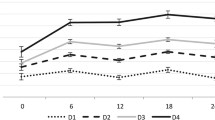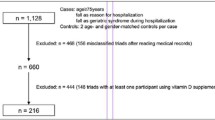Abstract
Summary
The present prospective follow-up study among 1,393 community-dwelling elderly women aged 75 years or older was conducted to clarify the association between serum 25-hydroxyvitamin D (25(OH)D) level and risk of falls. Lower serum 25(OH)D, particularly level <20 ng/mL, was significantly associated with an increased risk of falls.
Introduction
Serum 25(OH)D level has been revealed to be important factor not only for skeletal health but also for fall prevention among the elderly. Our previous cross-sectional study indicated that low serum 25(OH)D level is associated with inferior physical performance and falls among elderly Japanese women. The present prospective study was designed to clarify the association between serum 25(OH)D level and risk of falls before and after 1 year of follow-up.
Methods
The community-dwelling elderly women aged 75 years or older (N = 1,393) who participated in a mass health examination were followed 1 year later by a mailed self-administered questionnaire.
Results
Responses were obtained from 1,285 subjects (response rate = 92.2 %). The incidence of falls at baseline and at 1-year follow-up was 18.8 and 24.4 %, respectively. The baseline prevalence of serum 25(OH)D <20 ng/mL was 35.2 %. Odds ratios (95 % confidence intervals) in the lowest tertile of serum 25(OH)D (<20 ng/mL) compared with those in the highest tertile (≥25 ng/mL) were 1.40 (1.01–1.94) for any falls and 1.47 (0.93–2.32) for recurrent falls vs. no falls adjusted for potential risk factors.
Conclusions
Among elderly Japanese women, the lower serum 25(OH)D, particularly level <20 ng/mL, was significantly associated with an increased risk of falls.
Similar content being viewed by others
References
Ministry of Health, Labour and Welfare (2009) Comprehensive survey of living conditions of the people on health and welfare. 2007, Tokyo, Japan
Holick MF (2007) Vitamin D deficiency. N Engl J Med 357:266–281
Lips P (2001) Vitamin D deficiency and secondary hyperparathyroidism in the elderly: consequences for bone loss and fractures and therapeutic implications. Endocr Rev 22:477–501
Campbell PMF, Allain TJ (2006) Muscle strength and vitamin D in older people. Gerontol 52:335–338
Suzuki T, Kwon J, Kim H et al (2008) Low serum 25-hydroxyvitamin D levels associated with falls among Japanese community-dwelling elderly. J Bone Miner Res 23:1309–1317
Stewart JW, Alekel DL, Ritland LM, Van Loan M, Gertz E, Genschel U (2009) Serum 25-hydroxyvitamin D is related to indicators of overall physical fitness in healthy postmenopausal women. Menopause 16:1093–1101
Bischoff-Ferrari HA, Dietrich T, Orav EJ et al (2004) Higher 25-hydroxyvitamin D concentrations are associated with better lower-extremity function in both active and inactive persons aged ≥ 60y. Am J Clin Nutr 80:752–758
Wicherts IS, van Schoor NM, Boeke AJ et al (2007) Vitamin D status predicts physical performance and its decline in older persons. J Clin Endocrinol Metab 92:2058–2065
Houston DK, Cesari M, Ferrucci L et al (2007) Association between vitamin D status and physical performance: the InCHIANTI study. J Gerontol A Biol Sci Med Sci 62:440–446
Dam T-TL, von Mühlen D, Barrett-Connor EL (2009) Sex specific association of serum 25-hydroxyvitamin D levels with physical function in older adults. Osteoporos Int 20:751–760
Snijder MB, van Schoor NM, Pluijm SMF, van Dam RM, Visser M, Lips P (2006) Vitamin D status in relation to one-year risk of recurrent falling in older men and women. J Clin Endocrinol Metab 91:2980–2985
Rothenbacher D, Klenk J, Denkinger MD et al (2014) Prospective evaluation of renal function, serum vitamin D level, and risk of fall and fracture in community-dwelling elderly subjects. Osteoporos Int 25:923–932
Menant JC, Close JCT, Delbaere K et al (2012) Relationships between serum vitamin D levels, neuromuscular and neuropsychological function and falls in older men and women. Osteoporos Int 23:981–989
Suzuki T, Iwasa H, Yoshida H et al (2003) Comprehensive health examination (“Otasha-Kenshin”) for the prevention of geriatric syndromes and a bed-ridden state in the community elderly. 1. Differences in characteristics between participants and non-participants. Jpn J Public Health 50:39–48 [In Japanese with English summary]
Iwasa H, Yoshida H, Kim H et al (2006) A mortality comparison of participants and non-participants in a comprehensive health examination among elderly people living in an urban Japanese community. Aging Clin Exp Res 19:240–245
Iwasa H, Masui Y, Gondo Y et al (2009) Personality and participation in mass health checkups among Japanese community-dwelling elderly. J Psychosomatic Res 66:155–159
Haga H, Yasumura S, Niino N, Ueno H, Oshima M, Higuchi Y (1996) An examination of two reporting methods of falls among the elderly living in the community. Jpn J Public Health 43:983–988 [In Japanese with English summary]
Visser M, Kritchevsky SB, Newman AB et al (2005) Lower serum albumin concentration and change in muscle mass: the Health, Aging and Body Composition Study. Am J Clin Nutr 82:531–537
Kwon J, Suzuki T, Yoshida H, Kim H, Yoshida Y, Iwasa H (2007) Concomitant lower serum albumin and vitamin D levels are associated with decreased objective physical performance among Japanese community-dwelling elderly. Gerontol 53:322–328
Shimada H, Suzukawa M, Tiedemann A, Kobayashi K, Yoshida H, Suzuki T (2009) Which neuromuscular or cognitive test is the optimal screening tool to predict falls in frail community-dwelling older people? Gerontol 55:532–538
Holick MF, Binkley NC, Bichoff-Ferrari HA et al (2011) Evaluation, treatment, and prevention of vitamin D deficiency: an Endocrine Society clinical practice guideline. J Clin Endocrinol Metab 96(7):1911–1930
Chu LW, Chi I, Chiu AYY (2005) Incidence and predictors of falls in the Chinese elderly. Ann Acad Med Singapore 34:60–72
Barrett-Connor E, Weiss TW, McHorney CA, Miller PD, Siris ES (2009) Predictors of falls among postmenopausal women: results from National Osteoporosis Risk Assessment (NORA). Osteoporos Int 20:715–722
Nakamura K, Tsugawa N, Saito T et al (2008) Vitamin D status, bone mass, and bone metabolism in home-dwelling postmenopausal Japanese women: Yokogoshi Study. Bone 42:271–277
Holick MF (2006) High prevalence of vitamin D inadequacy and implications for health. Mayo Clin Proc 81:353–373
Freedman DM, Cahoon EK, Rajaraman P et al (2013) Sunlight and other determinants of circulating 25-hydroxyvitamin D levels in black and white participants in a nationwide US study. Am J Epidemiol 177(2):180–192
Wortsman J, Matsuoka LY, Chen TC, Lu Z, Holick MF (2000) Decreased bioavailability of vitamin D in obesity. Am J Clin Nutr 72:690–693
Dawson-Hughes B (2008) Serum 25-hydroxyvitamin D and functional outcomes in the elderly. Am J Clin Nutr 88(suppl):537S–540S
Dawson-Hughes B, Heaney RP, Holick MF, Lips P, Meunier PJ, Vieth R (2005) Estimates of optimal vitamin D status. Osteoporos Int 16:713–716
IOM (Institute of Medicine) (2011) Dietary reference intakes for calcium and vitamin D. The National Academics Press, Washington
Nakamura K (2006) Vitamin D and prevention of osteoporosis: Japanese perspective. Environ Health Prevent Med 11:271–276
Gaugris S, Heaney S, Boonen S, Kurth H, Bentkover JD, Sen SS (2005) Vitamin D inadequacy among post-menopausal women: a systematic review. Q J Med 98:667–676
Lips P, Duong T, Oleksik A et al (2001) A global study of vitamin D status and parathyroid function in postmenopausal women with osteoporosis: baseline data from the multiple outcomes of raloxifene evaluation clinical trial. J Clin Endocrinol Metab 86:1212–1221
Broe KE, Chen TC, Weinberg J et al (2007) A higher dose of vitamin D reduces the risk of falls in nursing home residents; a randomized, multiple-dose study. J Am Geriatr Soc 55:234–239
Visser M, Deeg DJH, Lips P (2003) Low vitamin D and high parathyroid hormone levels as determinants of loss of muscle strength and muscle mass (sarcopenia): the Longitudinal Aging Study Amsterdam. J Clin Endocrinol Metab 88:5766–5772
Kulie T, Groff A, Redmer J, Hounsbell J, Schrager S (2009) Vitamin D: an evidence-based review. J Am Board Fam Med 22:698–706
Faulkner KA, Cauley JA, Zmuda JM et al (2006) Higher 1,25-dihydroxyvitamin D3 concentrations associated with lower fall rates in older community-dwelling women. Osteoporos Int 17:1318–1328
Dukas LC, Schacht E, Mazor Z, Stӓhelin HB (2005) A new significant and independent risk factor for falls in elderly men and women: a low creatinine clearance of less than 65 ml/min. Osteoporos Int 16:332–338
Acknowledgments
This study was supported by a Grant-in Aid for Scientific research 20390189 (Director, Takao Suzuki) from the Ministry of Education, Culture, Sports, Science and Technology in Japan and by a Grant-in-Aid for Scientific Research H20-Choujyu-009 (Director, Noriko Yoshimura) from the Ministry of Health, Labour and Welfare in Japan.
Conflicts of interest
None.
Author information
Authors and Affiliations
Corresponding author
Rights and permissions
About this article
Cite this article
Shimizu, Y., Kim, H., Yoshida, H. et al. Serum 25-hydroxyvitamin D level and risk of falls in Japanese community-dwelling elderly women: a 1-year follow-up study. Osteoporos Int 26, 2185–2192 (2015). https://doi.org/10.1007/s00198-015-3130-1
Received:
Accepted:
Published:
Issue Date:
DOI: https://doi.org/10.1007/s00198-015-3130-1




